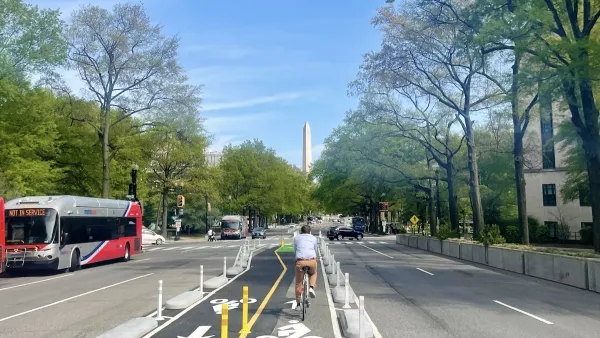By allowing the use of a new vehicle safety communication system called V2V, the U.S. Department of Transportation and the National Highway Traffic Safety Administration are hoping to protect drivers without overstepping privacy boundaries.
The DOT and NHTSA have announced that they will begin to allow vehicles to install V2V technology. After additional study by the NHTSA, the federal government could “eventually require the system to be included in all new vehicles,” reports Bridget Bowman.
The V2V technology is not an automated driving system, according to Bowman’s report. Rather, the new technology communicates with other cars in the area and provides warnings to the driver. (Another report by Mark Mooney from earlier this year provides more details on how V2V technology works.) A statement by Transportation Secretary Anthony Foxx on the new technology indicates, however, that government hopes the new technology has a dramatic effect for road safety: “Vehicle-to-vehicle technology represents the next generation of auto safety improvements, building on the life-saving achievements we’ve already seen with safety belts and air bags,…By helping drivers avoid crashes, this technology will play a key role in improving the way people get where they need to go…”
Also, “the communication technology does not involve any exchange of personal information nor does it identify or track specific vehicles. V2V would only transmit ‘basic safety data.’”
FULL STORY: U.S. Department of Transportation will allow vehicle-to-vehicle safety technology

Maui's Vacation Rental Debate Turns Ugly
Verbal attacks, misinformation campaigns and fistfights plague a high-stakes debate to convert thousands of vacation rentals into long-term housing.

Planetizen Federal Action Tracker
A weekly monitor of how Trump’s orders and actions are impacting planners and planning in America.

San Francisco Suspends Traffic Calming Amidst Record Deaths
Citing “a challenging fiscal landscape,” the city will cease the program on the heels of 42 traffic deaths, including 24 pedestrians.

Defunct Pittsburgh Power Plant to Become Residential Tower
A decommissioned steam heat plant will be redeveloped into almost 100 affordable housing units.

Trump Prompts Restructuring of Transportation Research Board in “Unprecedented Overreach”
The TRB has eliminated more than half of its committees including those focused on climate, equity, and cities.

Amtrak Rolls Out New Orleans to Alabama “Mardi Gras” Train
The new service will operate morning and evening departures between Mobile and New Orleans.
Urban Design for Planners 1: Software Tools
This six-course series explores essential urban design concepts using open source software and equips planners with the tools they need to participate fully in the urban design process.
Planning for Universal Design
Learn the tools for implementing Universal Design in planning regulations.
Heyer Gruel & Associates PA
JM Goldson LLC
Custer County Colorado
City of Camden Redevelopment Agency
City of Astoria
Transportation Research & Education Center (TREC) at Portland State University
Jefferson Parish Government
Camden Redevelopment Agency
City of Claremont



























